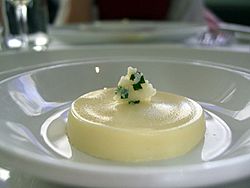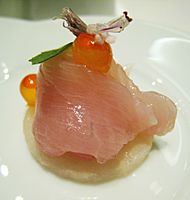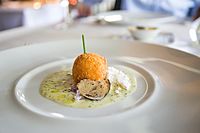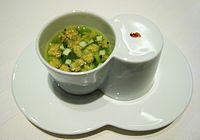Amuse-bouche facts for kids

A Parmesan panna cotta amuse-bouche
|
|
| Alternative names | Amuse-gueule |
|---|---|
| Course | Hors d'oeuvre |
| Place of origin | France |
An amuse-bouche (say "ah-mooz-BOOSH") or amuse-gueule (say "ah-mooz-GURL") is a very small, single bite of food. It's like a tiny, delicious surprise from the chef! These little treats are different from regular appetizers. You don't order them from a menu. Instead, the chef chooses them and gives them to you for free. They help get your taste buds ready for the meal. They also show you a little bit of the chef's cooking style.
The name "amuse-bouche" comes from the French words meaning "mouth amuser." In France, people often use the term amuse-gueule more in everyday talk. Amuse-bouche became popular on restaurant menus in the 1980s.
What is an Amuse-Bouche?
Amuse-bouches became well-known during a cooking movement called nouvelle cuisine. This style of cooking focused on smaller dishes with very strong flavors. An amuse-bouche is usually just one or two bites. It's always chosen by the chef and given to everyone at the table for free.
Why Chefs Love Them
Sometimes, an amuse-bouche can be simple, like a few olives. But often, it's a chance for the chef to show off their amazing cooking skills. It's a way for them to be creative and impress guests. Jean-Georges Vongerichten, a famous chef, once said that an amuse-bouche is the best way for a great chef to share big ideas in tiny bites.
Serving Amuse-Bouche
Over time, the amuse-bouche became a must-have at fancy restaurants. This includes places that have Michelin Guide stars. Serving these tiny dishes can be a bit tricky for restaurants. They need to make enough for everyone. They also need to serve them quickly, usually after you order or between main courses.
Restaurants often have a special area in the kitchen just for making amuse-bouches. They also need many different kinds of small, interesting plates or cups to serve them on. Chefs also have to be careful about guests who have allergies to certain ingredients.
Gallery
-
A Japanese-inspired amuse-bouche with hamachi, salmon roe, and basil.
See also
 In Spanish: Amuse-gueule para niños
In Spanish: Amuse-gueule para niños




